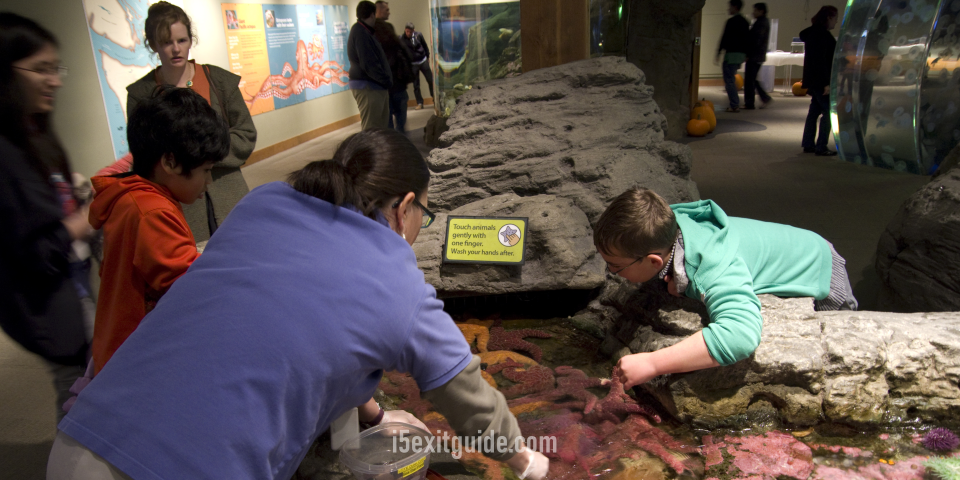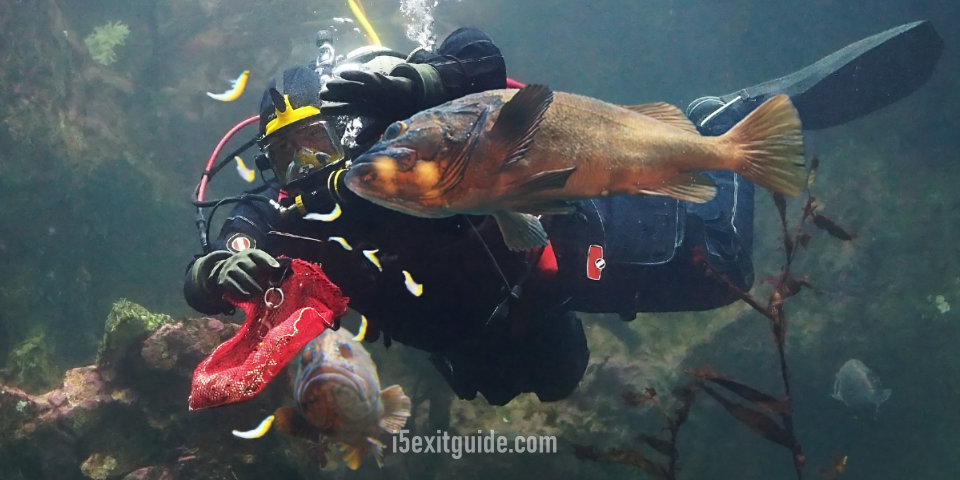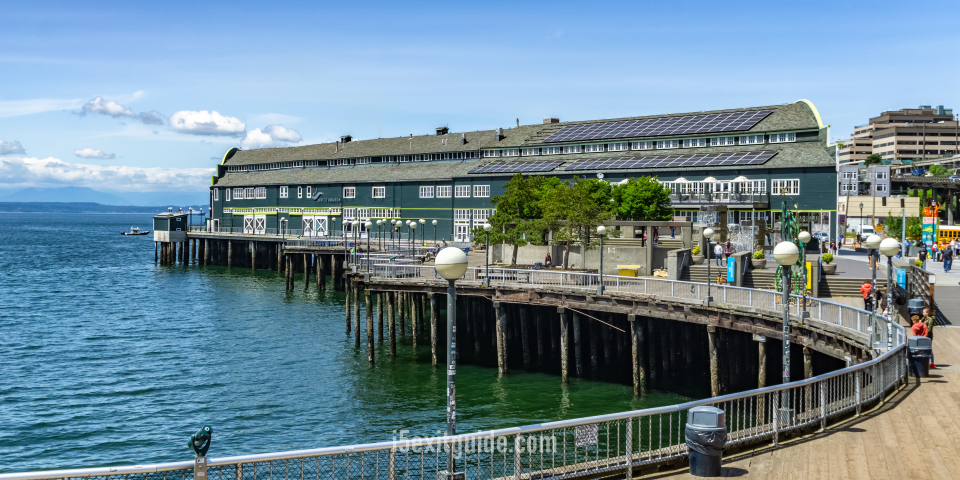Situated along the vibrant Seattle waterfront at Pier 59, the Seattle Aquarium is one of the city’s most popular attractions and a premier destination for understanding the rich marine ecosystems of the Pacific Northwest. Since opening its doors in 1977, this world-class facility has welcomed millions of visitors, offering an intimate look at the incredible diversity of life thriving in the waters of Puget Sound, the Pacific Ocean, and beyond. For travelers journeying along Interstate 5, the Seattle Aquarium represents an essential stop that combines education, conservation, and unforgettable encounters with marine life.
History and Mission
The Seattle Aquarium opened on May 20, 1977, becoming one of the first facilities in the United States to focus specifically on the marine life of a particular region rather than attempting to showcase species from around the world. This regional focus has remained central to its identity and mission. The aquarium was founded with the goal of fostering marine conservation through education and research, particularly focusing on the unique ecosystems of the Puget Sound and the greater Pacific Northwest.
Over the decades, the facility has undergone several expansions and renovations to enhance visitor experiences and improve animal habitats. A major expansion in 2007 added significant exhibit space and improved facilities for marine mammal care. The aquarium operates as a private, non-profit organization and is accredited by the Association of Zoos and Aquariums (AZA), ensuring it meets the highest standards for animal care, education, and conservation.
Major Exhibits and Attractions

Window on Washington Waters
This stunning 120,000-gallon exhibit serves as the aquarium’s centerpiece and offers visitors a mesmerizing view into the diverse habitats of Puget Sound. The exhibit features a massive curved acrylic window that creates an immersive experience, allowing guests to observe hundreds of native species swimming in a carefully recreated underwater environment. Rockfish, salmon, sturgeon, sharks, and rays glide past viewers, while colorful sea anemones, sea stars, and other invertebrates cling to rocky surfaces. The exhibit’s design mimics the natural depth gradient of Puget Sound, from shallow eelgrass beds to deeper waters, demonstrating how marine life varies with depth and habitat type.
Underwater Dome
One of the aquarium’s most iconic features, the Underwater Dome, provides a 360-degree view of Puget Sound marine life. Visitors descend into this spherical viewing chamber that sits partially submerged, surrounded by 400,000 gallons of seawater. The experience of being enveloped by water while watching salmon, octopuses, wolf eels, and other creatures swim overhead and around you creates an unforgettable sense of being beneath the waves. The dome connects directly to Elliott Bay, meaning the water temperature and conditions mirror the actual Sound, and the marine life experiences natural tidal changes.
Pacific Coral Reef
While the Seattle Aquarium focuses primarily on local ecosystems, this exhibit transports visitors to the tropical waters of the Pacific, showcasing the vibrant biodiversity of coral reef environments. Brilliantly colored fish dart among living corals, demonstrating the interconnected relationships that make coral reefs among Earth’s most productive ecosystems. This exhibit serves an important educational purpose, helping visitors understand the global importance of ocean health and the threats facing coral reefs worldwide due to climate change and other human impacts.
Marine Mammals

The aquarium’s marine mammal exhibits feature some of its most popular residents: sea otters and harbor seals. The sea otter exhibit allows visitors to watch these charismatic creatures both above and below the water’s surface as they play, groom, and demonstrate their remarkable tool-using abilities. Sea otters are keystone species in kelp forest ecosystems, and the aquarium’s educational programming helps visitors understand their crucial ecological role.
The harbor seal exhibit at the Seattle Aquarium provides similar dual viewing opportunities, with large windows allowing guests to observe these graceful swimmers underwater. Daily feeding presentations and training demonstrations show how aquarium staff care for these animals while providing mental and physical enrichment. These presentations also educate visitors about the biology, behavior, and conservation status of marine mammals in the wild.
Touch Pools and Interactive Experiences

The Life on the Edge tide pool exhibit offers hands-on encounters with marine invertebrates typical of Pacific Northwest shorelines. Under staff supervision, visitors can gently touch sea stars, sea cucumbers, sea anemones, and other creatures, learning about their biology and ecological roles. These tactile experiences create memorable connections, particularly for children, and help foster appreciation for marine life that might otherwise seem alien or unappealing.
Conservation and Research
The Seattle Aquarium serves as much more than a tourist attraction; it functions as an active center for marine research and conservation. The facility participates in numerous conservation initiatives focused on protecting and restoring Puget Sound’s marine ecosystems. Staff scientists conduct research on various species, contributing valuable data to our understanding of marine biology, animal behavior, and ecosystem health.
One of the aquarium’s most significant conservation efforts involves its work with sea otters. The facility has participated in sea otter rescue, rehabilitation, and research programs, contributing to efforts to restore sea otter populations along the Pacific coast. The aquarium also works on salmon conservation, studying the factors affecting salmon populations and supporting habitat restoration efforts throughout the region.
The facility’s Beach Naturalist program trains volunteers who then educate the public at beaches throughout the Puget Sound region, extending the aquarium’s educational mission beyond its walls. Additionally, the aquarium operates a marine mammal stranding network, responding to reports of sick, injured, or deceased marine mammals and sea turtles along Washington’s coast.
Educational Programs

Education stands at the core of the Seattle Aquarium’s mission. Beyond the exhibits themselves, the facility offers extensive programming for visitors of all ages. School field trips bring thousands of students to the aquarium each year, where they participate in curriculum-aligned programs that bring marine science to life. The aquarium also offers summer camps, overnight programs, and specialized classes that dive deeper into marine biology and conservation topics.
For adult learners, the aquarium hosts lectures, film screenings, and special events featuring marine scientists and conservationists. These programs keep the public informed about current research and emerging issues affecting ocean health.
Planning Your Visit
The Seattle Aquarium typically operates daily, with extended hours during summer months when tourist traffic peaks. Tickets can be purchased online in advance, which is highly recommended, especially during busy periods, as this allows visitors to select specific entry times and often provides modest discounts. The aquarium offers various ticket types, including annual memberships that provide unlimited visits and other benefits.
A typical visit lasts two to three hours, though marine life enthusiasts could easily spend longer exploring the exhibits and attending presentations. The aquarium schedules multiple daily presentations, including marine mammal feedings, dive shows in the Underwater Dome, and educational talks, so checking the daily schedule upon arrival helps visitors plan their time effectively.
The facility includes a café serving lunch items and snacks, as well as a gift shop offering marine-themed merchandise, educational materials, and locally made products. The aquarium is fully accessible to visitors with mobility challenges, with elevators and ramps providing access to all levels.
Address:
Seattle Aquarium
1483 Alaskan Way, Pier 59
Seattle, Washington 98101
Telephone: (206) 386-4300
Website: https://www.seattleaquarium.org/
Hours of Operation:
Monday: 9:30 am – 6:00 pm
Tuesday: 9:30 am – 6:00 pm
Wednesday: 9:30 am – 6:00 pm
Thursday: 9:30 am – 6:00 pm
Friday: 9:30 am – 6:00 pm
Saturday: 9:30 am – 6:00 pm
Sunday: 9:30 am – 6:00 pm
Last entry is 5:00 pm
Café: 10:00 am – 4:00 pm
Gift shops: 10:00 am – 6:00 pm
Admission:
Adults: Prices can range from about ($25) to over ($51) depending on the day
Washington residents (adults): Approximately ($40)
Children (ages 4-12): Approximately ($27)
Children (age 3 and under): Free
Directions:
The Seattle Aquarium enjoys a prime location on Seattle’s historic waterfront, making it easily accessible for tourists traveling through the region. From I-5, visitors can take exit 164A toward James Street and follow signs to the waterfront district. The aquarium sits at 1483 Alaskan Way, Pier 59, placing it at the heart of Seattle’s bustling waterfront area, adjacent to the Seattle Great Wheel and within walking distance of Pike Place Market, one of the nation’s most famous public markets.
Parking can be challenging in this busy tourist district, but several parking garages are available nearby, including the Seattle Waterfront Parking Garage. Many visitors choose to use public transportation, with multiple bus lines serving the waterfront area. The facility is also accessible via the Seattle Streetcar and light rail systems, making it convenient for those staying in downtown hotels or exploring the city without a car.
Combining Your Visit
The Seattle Aquarium’s waterfront location makes it ideal for combining with other Seattle attractions. Pike Place Market, located just a short walk up the hill, offers an iconic Seattle experience with its fish-throwing vendors, local crafts, and the original Starbucks. The Seattle Great Wheel, immediately adjacent to the aquarium, provides spectacular views of Elliott Bay and the city skyline. The waterfront area also features numerous restaurants, shops, and other attractions, making it easy to spend an entire day exploring this vibrant district.
For tourists traveling I-5, Seattle offers countless other attractions worth exploring, from the Space Needle and Museum of Pop Culture to the historic Pioneer Square neighborhood and the diverse restaurants and shops of Capitol Hill. However, the Seattle Aquarium provides something unique: a focused, in-depth exploration of the marine environment that defines the Pacific Northwest’s character and ecology.
Seattle Aquarium In a Nutshell
The Seattle Aquarium represents one of the Pacific Northwest’s premier attractions, offering visitors an accessible, engaging introduction to the region’s remarkable marine biodiversity. Through thoughtfully designed exhibits, hands-on experiences, and educational programming, the aquarium creates connections between people and the ocean, fostering understanding and inspiring conservation action. For travelers journeying along I-5, a stop at the Seattle Aquarium provides not just entertainment, but meaningful insight into the marine ecosystems that make the Pacific Northwest so special—an experience that will deepen your appreciation for the waters you’ve traveled beside and the life they sustain.
The I-5 Exit Guide is the Internet’s largest and most complete website dedicated to Interstate 5 travelers. Find detailed exit service listings… lodging, camping, food, gas and more for every exit from Washington to California!
On the road? Why not take us with you. The I-5 Exit Guide is mobile-friendly and totally FREE. No App Required.
Traveling another route? Visit our growing family of exit guides: I-4 Exit Guide, I-5 Exit Guide, I-10 Exit Guide, I-75 Exit Guide, I-80 Exit Guide and I-95 Exit Guide. Detailed exit service listings… discount lodging, camping, food, gas and more for every exit along the way!











